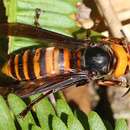en
names in breadcrumbs


The Asian giant hornet, Vespa mandarinia, a species native to temperate and tropical Eastern Asia, is the world's largest hornet. Adults can be up to 4.5 cm (1.8 inches) long (queens reach 5.5 cm long) and have a 6mm (0.25 inches) sting which injects a large amount of potent venom.
The Asian giant hornet is a relentless hunter that preys on other large insects, such as bees, other hornet species, and mantises.Asian giant hornets often and very effectively attack honey bee (genus Apis) hives.A single V. mandarinia scout, sometimes two or three, will cautiously approach the nest, giving off pheromones which will lead other hornets to the hive's location.Asian giant hornets, which are five times the size and 20 times the weight of a honey bee, can devastate a honey bee colony in a very short time: a single hornet can kill as many as 40 honey bees per minute thanks to its large mandibles. Once a hive is emptied of all defending bees, the hornets feed on the honey and carry the larvae back to feed to their own larvae.Adult Asian giant hornets cannot digest solid protein, so they do not eat their prey, but chew them into a paste and feed them to their larvae. Like many other vespid wasp species, adults themselves consume a clear liquid, Vespa amino acid mixture, which is produced by their own larvae.
The European honeybee (Apis mellifora), which has been imported for honey farming in Asia, has no natural defenses against giant Asian hornets and their hives are especially vulnerable to attack.However, Apis species native to Asia (for example Apis cerana japonica) have evolved strategies for defeating Vespa mandarinia attacks: if they detect a attacker in time the bee colony can form a “bee ball”, surrounding the hornet to very effectively suffocate it.
Humans can get a powerful and intensely painful sting from V. mandarina.The venom it injects is powerful, and about 40 deaths per year are reported as a result of stings that cause kidney and liver failure if not treated fast enough.Although it usually does not attack unless threatened or disturbed, the giant hornet can attack quickly and fiercely, flying up to 40 km (25 miles)/hour.
In Japan, Asian giant hornets are sometimes eaten raw or fried. Recently, several companies in Asia and Europe have begun to manufacture dietary supplements and energy drinks which contain synthetic versions of Vespa mandarinia larval amino acid secretion. The manufacturers of these products make claims that consuming the larval hornet secretions (marketed as "hornet juice") will enhance human endurance. (Handwerk 2002; Sugahara and Sakamoto 2009; Ono et al. 1995; Wikipedia 2011(a); Wikipedia 2011(b))